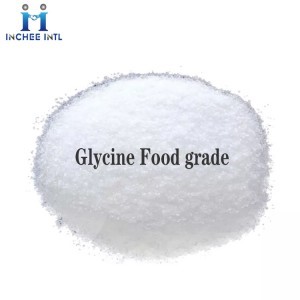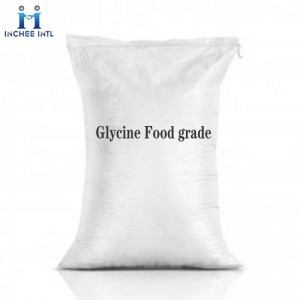Glycine (abbreviated Gly), also known as acetic acid, is a non-essential amino acid, its chemical formula is C2H5NO2.Glycine is an amino acid of endogenous antioxidant reduced glutathione, which is often supplemented by exogenous sources when the body is under severe stress, and is sometimes called semi-essential amino acid.Glycine is one of the simplest amino acids.
White monoclinic or hexagonal crystal, or white crystalline powder. Odorless, with special sweet taste. Easily soluble in water, solubility in water: 25g/100ml at 25℃; At 50℃, 39.1g/10Chemicalbook0ml; 54.4g/100ml at 75℃; At 100℃, it is 67.2g/100ml. Extremely insoluble in ethanol, about 0.06g dissolved in 100g anhydrous ethanol. Almost insoluble in acetone and ether.
Production method:
Strecker method and chloro-acetic acid ammonification method are the main preparation methods.
Strecker method: formaldehyde, sodium cyanide, ammonium chloride reaction together, then add glacial acetic acid, precipitation of methylene aminoacetonitrile; Amino acetonitrile sulfate was obtained by adding methylene acetonitrile to ethanol in the presence of sulfuric acid. The sulfate is decomposed by barium hydroxide to obtain glycine barium salt; Then sulfuric acid is added to precipitate the barium, filter it, concentrate the filtrate, and after cooling it precipitates glycine crystals. An experiment [NaCN] – > [NH4Cl] CH2 = N – CH2CNCH2 = N – CH2CN [- H2SO4] – > [C2H5OH] H2NCH2CN, H1SO4H2NCH2CN, – H2SO4 [BChemicalbooka (OH) 2] – (NH2CH2COO) 2 ba (NH2CH2COO) 2 ba [- H2SO4] – > H2NCH2COOH
Chloro-acetic acid ammoniation method: ammonia water and ammonium bicarbonate mixed heating to 55℃, adding chloro-acetic acid aqueous solution, reaction for 2h, then heating to 80℃ to remove residual ammonia, decolorization with activated carbon, filtration. The decolorizing solution was added with 95% ethanol to make the glycine crystallize out, filtered, washed with ethanol and dried to get the crude product. Dissolve in hot water and recrystallize with ethanol to obtain glycine. H2NCH2COOH ClCH2COOH [NH4HCO3] – > [NH4OH]
In addition, glycine is also extracted from silk hydrolysate and hydrolyzed with gelatin as raw material.
Application:
Food field
1, used as biochemical reagents, can also be used in medicine, feed and food additives, nitrogen fertilizer industry used as non-toxic decarbonizing agent;
2, used as a nutritional supplement, mainly used for seasoning and other aspects;
3, it has certain inhibitory effect on the reproduction of subtilis and Escherichia coli, so it can be used as a preservative for surimi products, peanut butter, etc., add 1% ~ 2%;
4, has the antioxidant effect (using its metal chelate cooperation), added to cream, cheese, margarine can extend the storage life of 3 ~ 4 times;
5. To stabilize lard in baked goods, glucose 2.5% and glycine 0.5% can be added;
6. Add 0.1% ~ 0.5% to wheat flour for quick cooking noodles, which can play a seasoning role at the same time;
7, the taste of salt and vinegar can play a buffer role, the amount of added salt products 0.3% ~ 0.7%, acid products 0.05% ~ 0.5%;
8, according to our GB2760-96 regulations can be used as spices.
Agricultural field
1. It is mainly used as an additive and attractant to increase amino acids in feed for poultry, livestock, especially pets. Used as a hydrolyzed protein additive, as a synergistic agent of hydrolyzed protein;
2, in the production of pesticides used in the synthesis of pyrethroid insecticide intermediate glycine ethyl ester hydrochloride, can also be synthesized fungicide isobiurea and herbicide solid glyphosate.
Industrial field
1, used as plating solution additive;
2, used in pharmaceutical industry, biochemical tests and organic synthesis;
3, used as cephalosporin raw materials, sulfoxamycin intermediate, imidazolacetic acid synthesis intermediate, etc.;
4, used as cosmetic raw materials.
Product Packaging:25kg/bag
Storage should be at cool, dry and ventilate.
Post time: May-04-2023








